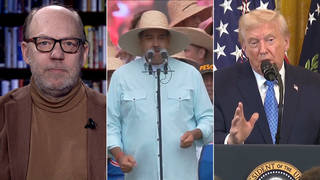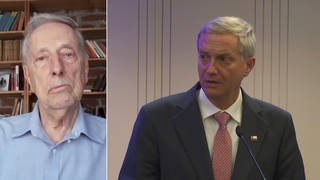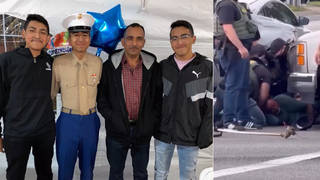
The Mexican government is demanding a full investigation after U.S. border authorities fired tear gas Sunday into a crowd of Central American asylum seekers as they tried to push their way through the heavily militarized border near San Diego. Among those attacked were mothers and small children, who were left gagging and screaming as tear gas spread. The migrants are mostly from Honduras, Guatemala and El Salvador and are fleeing widespread violence, poverty and mass unemployment. The Border Patrol’s use of tear gas has been widely condemned. Trump is now urging Mexico to deport the thousands of Central American migrants who are at or approaching the U.S. border in an attempt to seek asylum. We go to San Diego to speak with Pedro Rios, the director of the American Friends Service Committee’s U.S.-Mexico Border Program. He witnessed U.S. border agents using tear gas on Central American migrants on the U.S.-Mexico border on Sunday.
Transcript
JUAN GONZÁLEZ: The Mexican government is demanding a full investigation after U.S. border authorities fired tear gas Sunday into a crowd of Central American asylum seekers as they tried to push their way through the heavily militarized border near San Diego. Among those attacked were mothers and small children, who were left gagging and screaming as tear gas spread. The migrants are mostly from Honduras, Guatemala and El Salvador and are fleeing widespread violence, poverty and mass unemployment.
One photograph of the scene captured a Honduran mother grabbing the arms of her two 5-year-old twin daughters as they ran from a tear gas canister spewing fumes. One of the daughters is in diapers. The other is barefoot. The mother, Maria Meza, later spoke to Reuters about what happened.
MARIA MEZA: [translated] Well, I felt sad, scared and wanting to cry. That’s when I grabbed my daughters and started running. At that moment, I thought I was going to die with them because of the gas. We ran, and we fell into the mud and struggled to get up amidst the gas. A young man gave me his hand and pulled me up to my feet. I wasn’t expecting it. We never thought they were going to fire these bombs where there were children. Because there were lots of children, not just mine. There were more children with mothers there. They also started running, too, just like me. It wasn’t right. They know we are human beings, the same as them. It wasn’t right that they did that to the children. God is the only one who will open the doors to us to see if we can get into the U.S. or stay here in Tijuana and for doors to be open so that maybe we can be given papers to work here, because I’m a mother, and I need a job, work, to allow my children to survive.
AMY GOODMAN: The words of Honduran asylum seeker Maria Meza, who was photographed at the border being tear-gassed along with her twin daughters on Sunday. The Border Patrol’s use of tear gas has been widely condemned. The American Academy of Pediatrics said in a statement, “The use of tear gas on children—including infants and toddlers in diapers—goes against evidence-based recommendations, and threatens their short and long-term health.” On Monday, President Trump was asked about the tear gassing of children.
REPORTER: How did you feel when you saw the images of the women and children running from the tear gas?
PRESIDENT DONALD TRUMP: Well, I do say, why are they there? I mean, I have to start off—first of all, the tear gas is a very minor form of the tear gas itself. It’s very safe. The ones that were suffering to a certain extent were the people that were putting it out there. But it’s very safe. But you really say, why is a parent running up into an area where they know the tear gas is forming, and it’s going to be formed, and they’re running up with a child?
AMY GOODMAN: Meanwhile, Trump has urged Mexico to deport thousands of Central American migrants who are at or approaching the U.S. border in an attempt to seek asylum.
For more, we go to San Diego, California, where we’re joined by Pedro Rios, the director of the American Friends Service Committee’s U.S.-Mexico Border Program. He witnessed the U.S. border agents tear-gassing the migrants at the U.S.-Mexico border Sunday.
Welcome to Democracy Now!, Pedro. Can you describe what happened?
PEDRO RIOS: Thank you, Amy, for having me on the show. I was gathered with a number of people on the U.S. side, and we were witnessing as many of the migrants were coming over to the primary fence next to the pedestrian crossing-way in San Ysidro. Shortly thereafter, Border Patrol agents began firing what seemed to be these gas canisters into the crowd. We heard popping noises and whizzing noises. And we also witnessed how a helicopter flew down low enough to use its rotors to push this plume of smoke, of tear gas, into the canal where many of the migrants were gathering and had formed. And it was clearly an aggressive action meant to debilitate all of the people who were there, and my concern especially was for the children who were breathing in these toxic fumes.
JUAN GONZÁLEZ: And, Pedro, was there any warning issued by the Border Patrol to disperse before they actually started firing the tear gas?
PEDRO RIOS: The first shot that I heard did not come after any sort of warning. It was very quickly shot. It was one shot that I heard, one bang. And subsequent shots of tear gas, I did hear some sort of muffled warning or at least a vocal announcement. I believe that might have been some sort of call for dispersement. But the very first one did not follow any sort of warning.
JUAN GONZÁLEZ: I wanted to ask you—this comes in the days just before a major change of government in Mexico. Andrés Manuel López Obrador is scheduled to be inaugurated as the new president this weekend. There were reports in The Washington Post over the weekend that the Mexican government was arranging some kind of a deal with the Trump—or that López Obrador’s people were arranging some kind of deal with the U.S. government to keep the Central American asylum seekers in Mexico, possibly for months or even years, while their claims are being processed on the U.S. side. But then the Mexican government seemed to backtrack. Your sense of what’s going on now in the change of government in Mexico vis-à-vis this enormous crisis at the border?
PEDRO RIOS: Yeah, that’s exactly right. There was an announcement through a publication that there was some sort of deal reached in which Mexico would serve as a waiting room for people who had presented themselves at the ports and were filing for an asylum claim, so Mexico would then house them in some sort of way while they waited or wait years for their claims to be processed. It seems that the Mexican—incoming Mexican administration has stated that that’s not entirely true, that there are some sort of discussions taking place but that there hasn’t been any deal reached.
In any case, I think what that represents is just changes that would tremendously impact migrants who are, at this point, already waiting months, especially in Tijuana, where there is at least a 5,000 to 6,000 wait list. That could easily extend itself to three to four months while they try to figure out how to make their ends meet. We’re looking at the shelter where many of them are staying that has turned into a muddy mess with recent rains. We’re expecting rains to come later this week, which will exacerbate some of the concerns that we have, especially the health conditions that they’re living under, especially the children who are appearing in San Diego with upper respiratory illnesses and ear infections. And so this is clearly a humanitarian crisis that we’re seeing that both governments—the current Mexican government and the Trump administration—are not responding to as they should.
AMY GOODMAN: Speaking to CNN on Monday, the chief patrol agent of the Border Patrol San Diego Sector, Rodney Scott, defended the decision to tear-gas the migrants.
RODNEY SCOTT: I kind of challenge that this was a peaceful protest or that the majority of these people were claiming asylum. We ended up making about 42 arrests. Only eight of those were females, and there were only a few children involved. The vast majority of the people we’re dealing with are adult males. Similar to what we saw the first wave of the caravan that came up about a week or so ago, the group immediately started throwing rocks and debris at our agents, taunting the agents. Once our agents were assaulted and the numbers started growing—we had two or three agents at a time, initially, facing hundreds of people at a time—they deployed tear gas to protect themselves and to protect the border.
AMY GOODMAN: So that was the chief patrol agent of the Border Patrol’s San Diego Sector, Rodney Scott. Later he acknowledged none of his agents were seriously injured. Pedro Rios, if you can respond to what he said? And this excuse that the Trump administration has used, saying it’s mainly men, but then acknowledging it’s children, but Trump saying, “Oh, the gas is safe”?
PEDRO RIOS: Yeah, it’s inexcusable and completely unwarranted that the Border Patrol would resort to this sort of violence. And I think what it responds to is part of the political theater that the Trump administration is trying to configure, that the border community is out of control, that there’s a necessary response of violence, that they need to further militarize it by bringing troops to the border. And in this way, it fits a narrative that the Trump administration wants. They want more money in their budget for border walls. And this absolutely will be part of the debate that will be incoming with the continuing resolution ending on December 7th.
And so, the continuation of that discussion will surely be impacted by some of the images and clearly a manufactured crisis that the Trump administration is building in our communities. And it’s unfortunate, because it’s our communities that are feeling the impact. In San Ysidro alone, according to the San Ysidro Chamber of Commerce, in the five hours that the cross-border traffic was stopped, more than $5.3 million were lost in revenue just in San Ysidro, the small border town in San Diego County. So this has real significant impacts to our communities.
JUAN GONZÁLEZ: And, Pedro, I wanted to ask you about what is going on in terms of the Mexican society’s response to the Central American refugees. Apparently in some cities, they were welcomed as the caravans were moving north, but in Tijuana, there’s a mayor there who sounds awfully like a president here in the United States in the way he talks about immigrants. Could you talk about this new nativism developing within Mexico?
PEDRO RIOS: You know, it’s really interesting. Thank you for bringing that up. It’s really interesting, because Mayor Gastélum has espoused very similar statements that I would say, as you mentioned, sound like Donald Trump. His anti-migrant rhetoric essentially has been fanning the flames of a recent rise of nativism in Tijuana. But it’s a small group of people. I would say that most Tijuanenses, people from Tijuana, have been supportive of the migrants, especially around where the shelter is located. And so it’s a very similar response as we saw of Mexicans that were welcoming and providing, to some degree, protection as they were making their way up north through Mexico.
In this case, we have identified at least three individuals who were involved in that anti-migrant protest, of about 300 people, that actually work and reside in the U.S. One of them has been a clear proponent and fan of Donald Trump, and her Facebook page shows and indicates that she’s a resident of Chula Vista, which is the second-largest city in San Diego County. And so, it’s an opportunistic way of anti-immigrant people to travel to Tijuana and fan the flames of nativism, which the mayor of Tijuana has also been doing. And it’s an unfortunate response and clearly degrades the conditions of migrants who need to have their humanitarian needs met versus being attacked virulently by this sort of rhetoric and people that espouse these sentiments.
AMY GOODMAN: And what does it mean if Trump defies U.S. law, says asylum seekers cannot come into the U.S. to apply for asylum but have to apply in Mexico? How does that change the process for them?
PEDRO RIOS: Well, on the one hand, I think it places a larger burden on Mexican society, as we’re seeing right now, especially with the municipal government not taking the full responsibility and obligation that it should be, as well as the state and federal government in Mexico. It places much greater tensions and frustrations for migrants who are trying to figure out how to make ends meet.
And the U.S. is trying to absolve itself by the Trump administration not taking the full responsibility that it should, not ensuring that they are, as they are obligated to, take in people who are seeking asylum. It places people at greater risk, especially those who are in border towns like Tijuana where there has been an increase of violence because of infighting by the drug cartels. And so migrants will find themselves in the crosshairs of some of these dangerous circumstances.
And the Trump administration is simply trying to wash its hands and using this, again, false narrative of a border out of control to justify more money for increased enforcement, as well as his vanity wall.
AMY GOODMAN: Pedro Rios, we want to thank you for being with us, director of the American Friends Service Committee’s U.S.-Mexico Border Program, witnessing the U.S. border agents using tear gas on Central American migrants on the U.S.-Mexico border Sunday, speaking to us from San Diego.
When we come back, we’ll be joined by John Carlos Frey, the Emmy Award-winning investigative reporter, to talk about what’s happening there and the acquittal of a border agent who shot through a fence and killed a Mexican teenager on Mexico’s side. Stay with us.
















Media Options